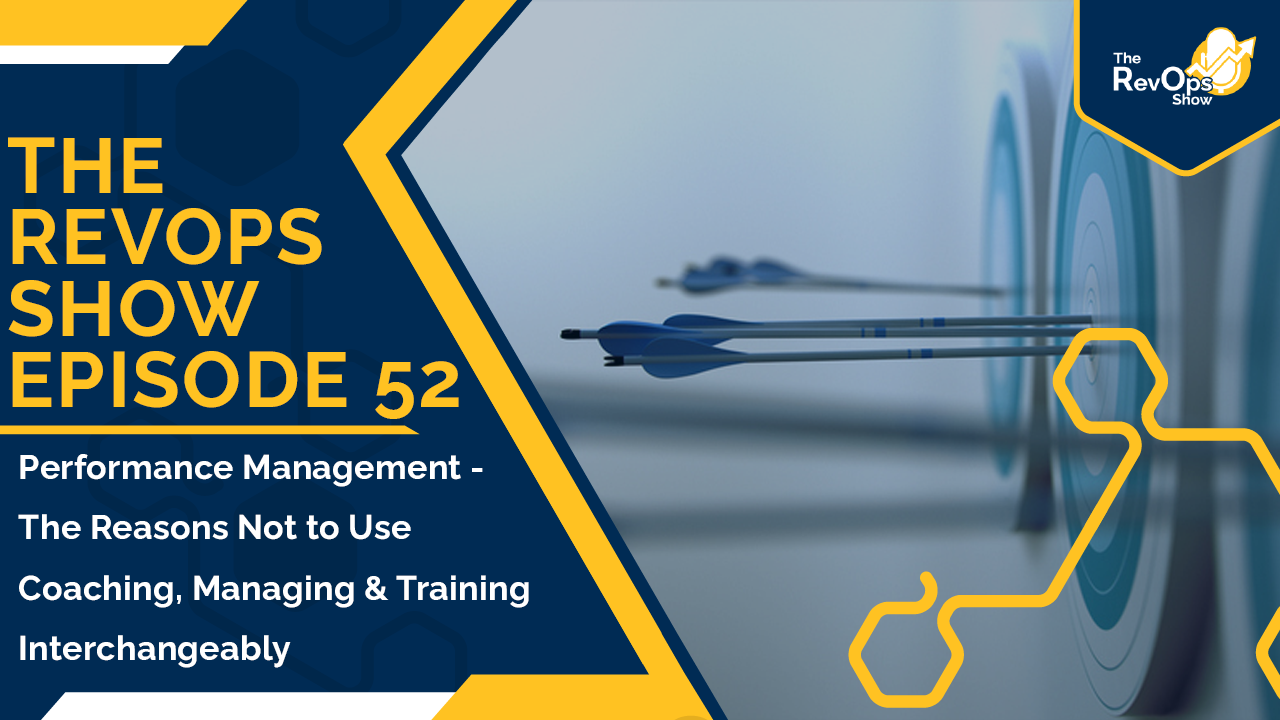9 days after recording this episode is opening day.
6 days after recording this episode, Doug sees Bruce Springsteen for the 47th time.
And today you get another episode of The RevOps Show!
Today’s topic: performance management and the difference between managing, training, and coaching.
Audio:
Video:

Additional Resources:
[RevOps Show] Episode 48: The Impact of Sales Methodologies
[Blog] 7 Sales Coaching Tips From An SDR's Point-of-View
[Blog] 5 Tips to Deliver Effective Coaching to Your Sales & Marketing Teams
[Blog] 3 Insights Into Effectively Managing Sales Development Reps (SDRs)
Show Notes:
What is performance management?
Doug categorizes managing, training, and coaching under this umbrella of performance management. It’s all about managing the performance of people.
Doug is a big believer in Goodhart's Law in which a good measure loses its goodness when it becomes an objective. He’s a big believer that you should never focus on getting a hit (baseball). But on the other side, at some point, you have to get hits. You have to start somewhere.
The other reason we’re calling out managing, training, and coaching today is that these terms get used synonymously.
Coaching and managing often get used together. Same with coaching and training. Hot take from Doug: Managing has more in common with training than coaching.
What is managing?
Managing is primarily about accountability, clarity, and advice. If you are managing, you’re looking at compliance in the sense of things being done that are supposed to be done. Is the methodology being followed?
There is also a support element. Does the person have what they need?
To Jess, it sounds like there’s a fine line between being able to manage and not going on a negative path. This is where Doug gets stumped. He doesn’t think you should go negative.
There are two sides to the coin. There are two sides; positivity and negativity. To only use one is a mistake. There’s friction and reduced friction. There are promoting elements and inhibiting elements. To only use one set of tools is a mistake.
What are the key pieces of training and what does that look like?
Training is teaching new skills; it’s a teaching element. There could be drills that you’re running. It’s building in repetition. Training is also an event.
For example: sales training. It’s not quite as big of a myth as it used to be, but there’s a question of why the sales team isn’t getting better. Doug’s joke here – what do you call a day of sales training? Some people say a waste of time. You’ll feel really good for the first few weeks after but then the performance improvement disappears.
Why do you see the performance improvement, to begin with?
You paid attention to something. Wherever you pay attention is where you would see the improvement.
Where training is good, especially from a sales context and from the performance management context, it’s a great way to launch something. It can also be good to finish something.
What is coaching?
Coaching is teaching to fish. Coaching is facilitating over and above everything. It’s facilitating the thought process and the approach so that one develops the capacity to do something on their own or to do it without oversight. When you’re coaching, you may have the impulse to correct somebody. But if you correct the person, there is no learning.
When you think about it training is teaching and coaching is building the capacity to learn.
Coaching is all about working on improving your decision quality. How are you making the decisions? How are you coming to do the things that you’re going to do? There can be touches of training in coaching. If you are training you’ll look at a conversation from more of a technical perspective.
If you’re looking at it through coaching you’ll have a basis to go off of. Coaching is a very soft discipline because you need to have knowledge and experience and the capability to coach in that specific area.
Why do we end up conflating managing, coaching, and training?
There are three reasons for this:
- Fear
- Laziness
- Lack of resources
Why fear and laziness?
When someone gets promoted they usually performed well to get to that position. In most large organizations, whatever onboarding is done is in company policies. Just because that person was a top performer doesn’t mean they are going to make a great manager.
Coaching is the complete opposite of whatever control is. When Doug is managing the outcome still matters, but when he’s coaching, he has to separate himself from the outcome.
Why laziness?
This stuff is hard. Doug does not think that every organization can have managing and coaching separated. If you’re a manager, it is really hard to be the coach for two reasons:
- If you are managing and go into coaching mode, don’t mistake that for coaching. If you're coaching and go into managing mode, don’t mistake that for coaching.
- One element of the coaching is separating yourself from the outcomes. You have to be able to be vulnerable with the coach.
It is not impossible to be both a manager and a coach. It takes an exceptional person to be able to do both.
Next Steps:
-
Follow Jess, Doug & Imagine on socials for updates on the show or other insights:
-
Doug Davidoff: Twitter - @dougdavidoff | LinkedIn
-
Jess Cardenas: Twitter - @JessDCardenas | LinkedIn
-
Imagine Business Development: Twitter - @DemandCreator | LinkedIn
-
-
Subscribe to the show on Spotify & Apple Podcasts
-
Check out Let's Play RevOps on Twitch for more commentary on this topic
-
Listen to Episode 53: Building The Ideal Tech Stack - What You Need to Know & How to Make It Happen
